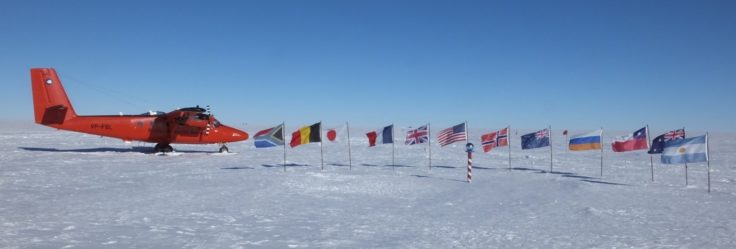Record warming at the South Pole
The South Pole has warmed at over three times the global rate since 1989, according to a paper published in Nature Climate Change today (29 June 2020). This warming period was mainly driven by natural tropical climate variability and was likely intensified by increases in greenhouse gases, the authors suggest.
The Antarctic climate exhibits some of the largest ranges in temperature over the course of a year, and some of the largest temperature trends on the planet, with strong regional contrasts. Most of West Antarctica and the Antarctic Peninsula experienced warming and ice-sheet thinning during the late twentieth century. By contrast, the South Pole — located in the remote and high-altitude continental interior — cooled until the 1980s, but has since warmed substantially. These trends are affected by natural and anthropogenic climate change, but the individual contribution of each factor is not well understood and challenging to precisely determine.

A team of scientists analysed weather station data, gridded observations and climate model simulations to examine the warming trend at the South Pole. Their study found that the strong warming over the Antarctic interior during the last 30 years was chiefly driven by the tropics, especially warm ocean temperatures in the western tropical Pacific Ocean, which has lowered atmospheric pressure over the Weddell Sea (high-latitude South Atlantic) and increased the delivery of warm air to the South Pole. The authors suggest these atmospheric changes along Antarctica’s coast are an important mechanism driving extreme multi-decadal climate anomalies in its interior.
British Antarctic Survey climate scientist and co-author, Professor John Turner, says:
“The South Pole is one of the most remote places on Earth, but our study has highlighted that Antarctica is closely linked to the rest of the global climate system, with the recent temperature increase a result of warming of the western tropical Pacific Ocean”.
The authors argue that these warming trends were unlikely the result of natural climate change alone, emphasizing the effects of anthropogenic warming on top of the large tropical climate signal in Antarctic climate have worked in tandem to make this one of the strongest warming trends on Earth.
Co-author Dr Gareth Marshall is a senior climatoligist at BAS. He says:
“During the latter half of the twentieth century the South Pole appeared to be untouched by global warming, in part because the ozone hole accelerated the westerly winds around the Antarctic continent, reducing the southward movement of warmer air: indeed, temperatures actually got slightly colder.
“However, in the twenty-first century a switch in tropical climate variability combined with the stronger westerlies to open up an atmospheric corridor in the South Atlantic, has allowed warm air to reach the South Pole. As a result, and in marked contrast to what was observed before, over the last 30 years the South Pole has warmed very quickly, at more than three times the global average. This study clearly demonstrates that the remoteness of a region is no barrier to it being susceptible to rapid climate change.”
Record warming at the South Pole during the past three decades by Clem, K., R. L. Fogt, J. Turner, B. R. Lintner, G. Marshall, J. R. Miller, A. J. Broccoli and J. Renwick (2020) is published in the journal Nature Climate Change.